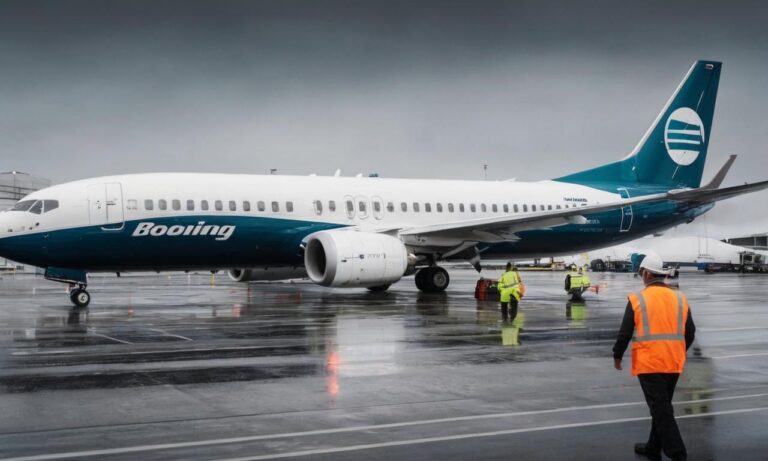The safety record of the Boeing 737 Max 8 has been a topic of significant concern and scrutiny in recent years. This article aims to provide a comprehensive overview of the safety performance of the Boeing 737 Max 8, addressing key aspects and controversies surrounding its operation.
The Genesis of Concerns
Boeing’s 737 Max 8 faced intense scrutiny following two high-profile accidents – Lion Air Flight 610 in October 2018 and Ethiopian Airlines Flight 302 in March 2019. Both incidents involved the aircraft’s Maneuvering Characteristics Augmentation System (MCAS), a software system designed to enhance stability.
MCAS and Safety Measures
The MCAS system became a focal point of investigation as it was implicated in the accidents. Boeing, in response, implemented software updates and additional pilot training to address potential safety concerns. The Federal Aviation Administration (FAA) and other global aviation authorities also played pivotal roles in evaluating and approving these changes.
Regulatory Oversight
The regulatory response to the Boeing 737 Max 8 incidents showcased the importance of collaboration between aviation manufacturers and oversight bodies. The FAA’s role in re-certifying the aircraft underscored the need for rigorous safety evaluations, leading to increased transparency and accountability in the aviation industry.
Operational Improvements
Boeing has continually worked to enhance the safety features of the 737 Max 8, incorporating lessons learned from the aforementioned accidents. The aviation giant focused on strengthening its safety culture, emphasizing pilot training, and fostering open communication with regulatory authorities to ensure ongoing compliance with global aviation standards.
Industry Collaboration
The aviation community, including airlines, pilots, and regulatory bodies, has actively collaborated to address safety concerns related to the Boeing 737 Max 8. Industry-wide initiatives have aimed at sharing best practices, improving training protocols, and fostering a collective commitment to aviation safety.
Public Perception and Trust
Rebuilding public trust in the safety of the Boeing 737 Max 8 has been an ongoing challenge. Effective communication, transparency, and a commitment to safety have been crucial in restoring confidence among passengers, airlines, and the general public.
While the Boeing 737 Max 8 faced challenges and controversies related to its safety record, concerted efforts from Boeing, regulatory authorities, and the aviation industry have led to significant improvements. Continuous vigilance, collaboration, and adherence to the highest safety standards remain paramount in ensuring the ongoing safety of the Boeing 737 Max 8 and other aircraft in the global aviation fleet.
Frequently Asked Questions
As discussions around the Boeing 737 Max 8 safety record persist, several questions arise. Here, we address common inquiries to provide clarity on the ongoing concerns and developments.
1. What specific changes were made to the MCAS system?
Boeing introduced software updates to the MCAS system, modifying its functionality to prevent unwanted activation. Additionally, enhanced pilot training programs were implemented to ensure a better understanding of the system and its potential implications.
The re-certification process involved close collaboration between the FAA and international aviation regulators. Joint evaluations, data sharing, and consensus-building efforts were undertaken to ensure a comprehensive and standardized approach to validating the safety improvements made by Boeing.
3. What initiatives have airlines taken to address passenger concerns?
Airlines operating the Boeing 737 Max 8 have invested in communication strategies to address passenger concerns. This includes transparent disclosure of the aircraft type during booking, updated safety information on board, and educational materials to inform passengers about the implemented safety enhancements.
Technological Advancements
Amidst safety concerns, technological advancements have played a crucial role in shaping the future of aircraft design. Innovations such as advanced sensors, artificial intelligence, and real-time data analytics are being integrated into newer aircraft models to further enhance safety and operational efficiency.
1. Sensor Technology and Redundancy
Newer aircraft models are equipped with advanced sensor technologies, offering increased redundancy and more reliable data inputs. This ensures that critical systems, including those related to flight control, have redundant sensor inputs to prevent a single point of failure.
2. Artificial Intelligence in Aviation
The aviation industry is embracing artificial intelligence (AI) to improve decision-making processes and enhance the safety of flight operations. AI algorithms analyze vast amounts of data in real-time, assisting pilots in making more informed decisions and predicting potential issues before they escalate.
3. Real-time Monitoring and Predictive Maintenance
Real-time monitoring systems and predictive maintenance technologies are becoming integral to aircraft operations. These innovations allow airlines to proactively address potential issues, reduce unplanned maintenance events, and enhance overall safety and reliability.
Global Regulatory Landscape
Ensuring the safety of aircraft involves collaboration on a global scale. The evolving regulatory landscape continues to adapt to emerging technologies and challenges, shaping the framework for international aviation safety standards.
1. Cross-Border Collaboration
International collaboration among aviation regulators is essential to establish consistent safety standards. Organizations such as the International Civil Aviation Organization (ICAO) facilitate cooperation between countries, promoting the harmonization of regulations to ensure a unified approach to aviation safety.
2. Emerging Technologies and Regulatory Frameworks
The rapid evolution of aviation technologies poses challenges to existing regulatory frameworks. Regulatory bodies worldwide are actively engaged in developing adaptable frameworks that can accommodate innovations while maintaining the highest safety standards for both conventional and advanced aircraft.






